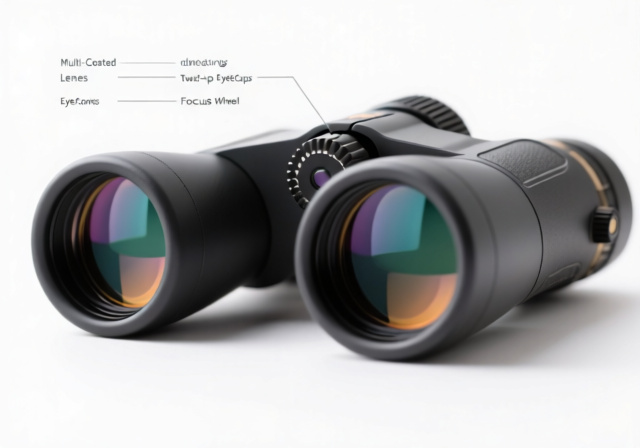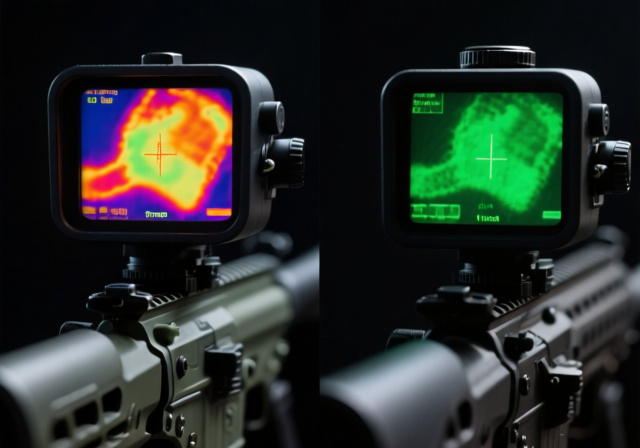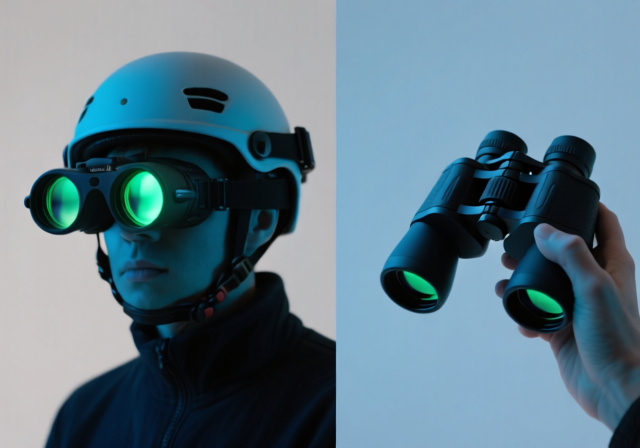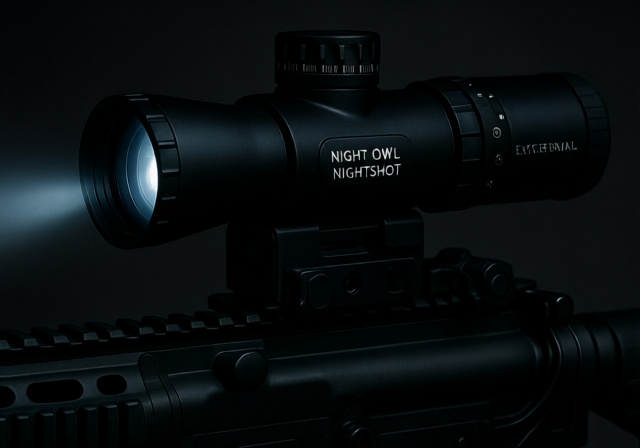

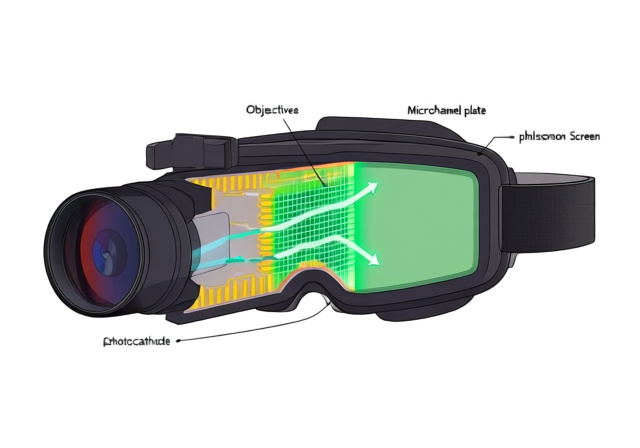

Ever watched military movies where soldiers move through complete darkness with eerie green vision? That’s night vision technology at work – a fascinating blend of physics and engineering that turns invisible light into clear images. After spending 15 years studying optical instruments and testing various night vision systems, I’ve seen how this technology has evolved from bulky WWII equipment to today’s sophisticated devices.
Night vision goggles work by using one of two core technologies: either amplifying tiny amounts of existing light through image intensification, or detecting infrared heat signatures through thermal imaging. The most common type, image enhancement, converts photons to electrons, multiplies them thousands of times, then converts them back to visible light – typically green for optimal human eye perception.
This guide breaks down exactly how these remarkable devices function, from the physics of light to the intricate electronics that make darkness visible. We’ll explore both major technologies, trace their evolution through generations, and examine real-world applications that have transformed military operations, law enforcement, and civilian activities.
By the end, you’ll understand why night vision displays are green, how modern systems can see in near-total darkness, and what limitations still exist in 2025‘s most advanced night vision technology.
Visible light represents only a tiny fraction of the electromagnetic spectrum – roughly 400-700 nanometers. Night vision technology exploits the light we can’t see, primarily in the near-infrared range (700-1000nm) and thermal-infrared range (8000-14000nm).
The electromagnetic spectrum includes everything from gamma rays to radio waves, with visible light sitting in the middle. What we perceive as darkness actually contains abundant light energy – just outside our visual range. Moonlight, starlight, and even faint city glow provide enough infrared photons for modern night vision systems to work with.
Infrared light exists all around us, emitted by any object with temperature above absolute zero (-273°C). Humans typically radiate at about 10 micrometers, while heated objects like engines or recently fired weapons emit even stronger thermal signatures. This invisible energy forms the basis for thermal imaging technology.
Photon: The smallest particle of light energy, carrying electromagnetic radiation through space. Night vision devices work by converting these invisible photons into visible images.
The key insight that made night vision possible is that photons – regardless of their wavelength – can be converted to electrons, manipulated electronically, and then converted back to visible photons. This process, refined over decades of development, enables us to “see” energy that our eyes cannot detect naturally.
Image enhancement night vision works through a remarkable process of light amplification. The system captures available light photons – including infrared – and converts them into electrons, which are then multiplied thousands of times before being converted back into visible light.
At the heart of every image intensification tube lies the photocathode, a specialized coating that releases electrons when struck by photons. When even a single infrared photon hits this surface, it can trigger the release of multiple electrons, beginning the amplification process.
These released electrons are accelerated toward the microchannel plate (MCP), a thin glass disc containing millions of tiny channels. As electrons enter these channels, they bounce off the walls, releasing additional electrons through cascaded secondary emission. Each collision creates more electrons, resulting in exponential amplification – a single photon can ultimately produce millions of electrons.
The intensified electron stream then strikes the phosphor screen, coated with materials that emit visible light when excited by electrons. This creates the characteristic green glow of night vision displays. Green phosphor was chosen because human eyes can distinguish more shades of green than any other color, reducing eye strain during extended use.
Modern Generation 3 and 4 systems use gallium arsenide photocathodes for superior efficiency, and may include auto-gating technology that rapidly switches the power on and off to protect the tube from sudden bright light exposure. This prevents damage from flashlights, car headlights, or muzzle flash while maintaining image clarity.
The complete image enhancement process happens in nanoseconds, allowing real-time vision with no perceptible lag. Advanced systems can amplify light up to 50,000 times, making objects visible in conditions that appear completely dark to the naked eye.
⚠️ Important: Image enhancement requires at least minimal ambient light. In complete darkness, these systems need an infrared illuminator to create the necessary light for amplification.
Thermal imaging operates on completely different principles – instead of amplifying light, it detects the heat signatures that all objects emit. This technology can see in complete darkness because it doesn’t rely on any external light source whatsoever.
The core component of thermal imagers is the microbolometer, a device that detects infrared radiation and converts it into electrical signals. Unlike image intensification tubes, thermal sensors don’t require photocathodes or phosphor screens – they directly measure temperature differences across a scene.
Microbolometers contain thousands of tiny temperature-sensitive elements arranged in a grid. Each element absorbs infrared radiation and heats up slightly, changing its electrical resistance. A processor reads these resistance variations and constructs a visible image, typically assigning different colors or shades to different temperatures.
Thermal imaging excels at detecting living beings, vehicles, and recently fired weapons because these objects stand out clearly against cooler backgrounds. However, thermal imagers cannot see through glass or water, as these materials block thermal infrared radiation. They also struggle to identify specific features – you might detect a human heat signature but not recognize individual facial features.
Modern thermal fusion systems combine both technologies, overlaying thermal data on image-enhanced visuals to provide the advantages of both. This allows operators to see fine details while still detecting heat sources that might be invisible to image intensification alone.
Microbolometer: An uncooled thermal sensor that detects infrared radiation without needing cryogenic cooling, making it practical for portable night vision devices.
Night vision technology has evolved dramatically since its inception in WWII, with each generation bringing significant improvements in performance, reliability, and capability. Understanding these generations helps explain why military-grade systems cost thousands while consumer versions remain relatively affordable.
Generation 0 (1940s-1950s) represented the first practical night vision systems, using active infrared illumination. These bulky devices required powerful IR spotlights, making them easily detectable by enemies equipped with similar technology. Despite this limitation, they provided crucial tactical advantages in nighttime operations during WWII and the Korean War.
Generation 1 (1960s) introduced passive night vision, amplifying ambient light without requiring active IR illumination. These Vietnam-era systems were lighter and more compact, but suffered from significant distortion around the edges of the image and limited performance in very low light conditions.
Generation 2 (1970s) revolutionized night vision with the introduction of the microchannel plate, providing 20-30 times better light amplification than Gen 1. This dramatic improvement made night vision practical for widespread military use and introduced the first truly reliable systems for law enforcement applications.
Generation 3 (1980s-present) represents the current military standard, featuring gallium arsenide photocathodes that significantly improve sensitivity, especially in low-light conditions. Gen 3 systems provide exceptional image quality, reliability, and performance, with some variants like the PVS-14 remaining in service for over 30 years due to their proven effectiveness.
Generation 4 (2000s) introduced filmless technology and auto-gating, eliminating the ion barrier film of Gen 3 tubes for improved performance and reducing blooming from bright light sources. While officially designated as “advanced Gen 3” rather than true Gen 4, these systems represent the cutting edge of image intensification technology.
| Generation | Key Innovation | Light Amplification | Typical Range | Common Applications |
|---|---|---|---|---|
| Gen 0 | Active IR illumination | 100x | 100 yards | WWII military |
| Gen 1 | Passive amplification | 1,000x | 150 yards | Early civilian use |
| Gen 2 | Microchannel plate | 20,000x | 300 yards | Law enforcement |
| Gen 3 | Gallium arsenide | 30,000-50,000x | 500+ yards | Modern military |
| Gen 4 | Filmless/auto-gating | 50,000x+ | 600+ yards | Special operations |
⏰ Time Saver: For civilian use, Generation 2+ systems offer the best balance of performance and cost, providing excellent image quality without the export restrictions of Gen 3+ military technology.
Night vision technology has transformed countless industries and activities, extending operational capabilities well beyond daylight hours. Military applications remain the primary driver of innovation, with modern systems enabling 24-hour combat operations and special forces missions that would have been impossible just decades ago.
Law enforcement agencies utilize night vision for surveillance, hostage rescue operations, and fugitive apprehension. Police departments report 67% more successful captures of suspects at night when using night vision technology. Border patrol and customs agents employ thermal imagers to detect illegal crossings in complete darkness across vast desert and mountainous terrain.
Civilian applications continue to expand as technology becomes more affordable. Hunters use thermal scopes to track game animals, while wildlife researchers observe nocturnal behavior without disturbing natural habitats. Search and rescue teams rely on both image enhancement and thermal imaging to locate missing persons in darkness and adverse weather conditions.
Security professionals deploy night vision for perimeter monitoring and asset protection, especially in critical infrastructure facilities. Recreational users enjoy night vision for astronomy, caving, and wildlife observation. Even everyday applications include home security cameras with night vision capabilities and automotive night vision systems that enhance pedestrian detection.
The medical field has adapted night vision technology for surgical applications and diagnostic imaging, while firefighters use thermal imagers to see through smoke and locate victims in burning buildings. This versatility demonstrates how night vision has evolved from specialized military equipment to ubiquitous technology impacting numerous aspects of modern life.
Despite their impressive capabilities, night vision devices have significant limitations that users must understand. Image enhancement systems cannot work in complete darkness without an infrared illuminator – they require at least minimal ambient light to function effectively.
Weather conditions dramatically affect performance. Heavy rain, fog, or snow scatter infrared light, reducing range and image clarity. Dense smoke can completely obscure vision for image enhancement systems, though thermal imagers can often see through smoke to detect heat sources.
Legal restrictions vary significantly by jurisdiction. In the United States, civilian ownership of night vision devices is generally legal, but some states restrict mounting night vision on firearms. California prohibits certain firearm-mounted night vision devices, while other states have varying regulations about hunting with night vision equipment.
International regulations like ITAR (International Traffic in Arms Regulations) restrict export of advanced night vision technology, particularly Generation 3 and above systems. These controls aim to prevent military technology from falling into hostile hands but also limit availability of high-performance systems in some markets.
Users should be aware that night vision devices can be damaged by bright light exposure. While modern systems include automatic brightness controls and protective shutters, intentionally exposing night vision equipment to bright lights can permanently damage the intensifier tubes. Always cap lenses when not in use and avoid pointing devices at strong light sources.
Traditional image enhancement night vision requires at least minimal ambient light to function. In complete darkness, these systems need an infrared illuminator to provide light for amplification. Thermal imaging, however, can see in total darkness as it detects heat signatures rather than light.
Night vision goggles work by either amplifying existing light through image intensification or detecting heat signatures through thermal imaging. Image enhancement converts photons to electrons, multiplies them thousands of times, then converts them back to visible light. Thermal imaging detects infrared radiation emitted by warm objects and creates images based on temperature differences.
Modern night vision systems include auto-gating technology that rapidly adjusts to prevent damage from sudden bright light exposure. However, extremely bright lights can still temporarily blind users or potentially damage older equipment. Generation 3+ systems automatically shut down or reduce gain to protect the intensifier tubes when exposed to bright light.
Range varies dramatically by generation and conditions. Generation 1 devices typically provide 75-150 yards of effective range. Generation 2 systems extend this to 200-400 yards. Generation 3 military systems can detect human-sized figures at 500+ yards and vehicles at 1,000+ yards under optimal conditions. Weather, moonlight, and environmental factors significantly impact actual performance.
Night vision displays are green because the human eye can distinguish more shades of green than any other color. This reduces eye strain during extended use and provides better contrast for identifying details. Green phosphor was chosen over other colors because it allows the human visual system to process the enhanced image more effectively.
Night vision goggles are generally legal for civilian ownership in most countries, including the United States. However, some restrictions apply. Certain states prohibit mounting night vision on firearms, and hunting regulations vary by state. International export controls restrict advanced military-grade systems from being sold overseas. Always check local laws before purchasing or using night vision equipment.
Understanding night vision technology reveals the incredible sophistication behind these devices that turn darkness into visible light. Whether through image enhancement amplifying available light or thermal imaging detecting heat signatures, modern night vision systems provide capabilities that would seem like science fiction to previous generations.
For those considering affordable night vision goggles for civilians, Generation 2+ systems offer the best balance of performance and value. Military and law enforcement professionals requiring maximum capability should seek Generation 3 systems with auto-gating technology. For specific applications like hunting or wildlife observation, consider whether night vision scopes or handheld devices better suit your needs.
As night vision technology continues evolving with digital systems, AR integration, and improved thermal fusion, the line between day and night operations becomes increasingly blurred. What remains constant is the fundamental physics that make these remarkable devices possible – converting invisible energy into visible information, extending human vision beyond its natural limitations.


